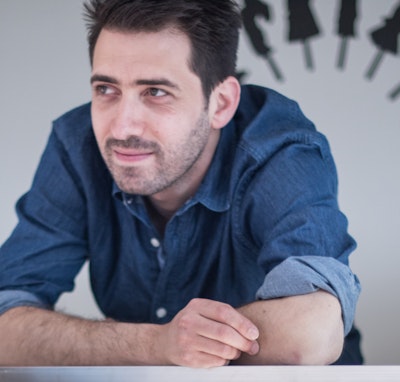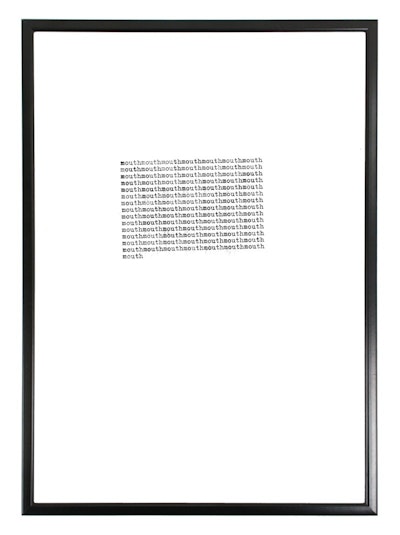Conversation in tandem with Delphine Guillaud (Backslash, Paris) and artist Simon Niçaise, led by Emanuela Mazzonis
Emanuela Mazzonis: Good morning, Delphine Guillaud and Simon Nicaise. Thank you for being with us today and for participating in this cycle of interviews organised by Luxembourg Art Week and dedicated to a selection of galleries participating in the fair for the first time. I’m Emanuela Mazzonis, editor of this project. I would like to start by asking Delphine to introduce Backs\ash, which was founded in 2010 in Paris. The gallery represents international artists and regularly participates in fairs in France and abroad. Can you tell us more about the name?
Delphine Guillaud: A backslash is a typographic symbol widely used in computing as a way to separate elements of a file path, for instance under Linux and Windows. It’s the sign that initialises most folders on your computer. For us, it represents the beginning of a story and its long-term continuity. Working with artists is a strong and lasting commitment for our team. We want to invest in the careers of artists and support them as much as possible. The root of each artist folder on our computers begins with a backslash.
EM: Simon, when looking at your works, the first thing that comes to mind is that you work not only with materials and space, but also with time and the temporal ambiguity that surrounds objects. You use many different materials (wax, bronze, plaster, ceramics, concrete, wood, terracotta) and your artistic process is quite intense: assembling, mounting, magnetising, piercing, suspending, supporting, balancing, adding and removing. You divert objects from their primary function to lend them a new meaning that is simultaneously powerful and fragile. I’m thinking of your works with cigarettes, such as Ultima Necat (2018), a sundial whose stylus consists of a cigarette, and Mobile parmi les Mobiles (2012–16), in which cigarettes are attached to a mobile consisting of thin rods connected by small magnets; with roses, such as Eternal Rose (2016), where the roses have been dipped in lead, and Lionnel (2018), 32 roses dipped in wax; with water, such as Cannibalisation d’une goutte d’eau (2010–16), where small snowballs are locked in a freezer; with matches (Sulfide d’antimoine, 2018), copper (Sans titre, 2016), and concrete like the triptych Amours en cage (2016). Your art is a constant dialogue between materialisation and dissolution, appearance and disappearance, tension and relaxation. You encourage viewers to recontextualise the meaning of the objects. How important is the essence of the object from which you start and to what extent do the materials you use influence the final work?
Simon Nicaise: The actions you just mentioned remind me of Richard Serra’s Verb List (1967), which I’ve always found very interesting. It’s about the actions that make it possible to engage with an object materially and to project oneself mentally into a form. I would say that my practice is about putting objects or materials to the test by teasing out their emotional charge. The materials that I choose and on which I work are materials with which I establish affective, loving relationships. It’s a connection that exists in both my life and my work. This concentration produces a form of dialogue that is continued through the transformation and displacement of the object. This concentration also applies to the consistency of the process. A both physical and mental material is transformed into tools that allow me to create situations that allow me to create tools that allow me to create situations that allow me to create tools. It’s the idea of a loop where functions can be reset. I work on objects by charging them with tensions. By introducing fragility to elements that are supposed to resist the order of time, or, conversely, by stabilising states that are usually evanescent, I seek to create bridges, to pull a thread through space that crosses two points and brings them together. I draw a line between two elements and, through a sort of back-and-forth movement, I observe their breaking and meeting points. I operate and experiment in this in-between space, a space where a vibration can happen, where a balancing act takes place, where antagonisms can be reconciled. I’m not an expert at any technique and do not wish to become one, even if indeed certain materials reoccur in my work. I’m also interested in the different states of one and the same material. In some of my works, different states can co-exist. For example, Mobile parmi les mobiles is a work that unfolds in three sequences. Twenty cigarettes are suspended on a mobile. This is the first moment in the existence of the mobile, before it comes to life. The second sequence is when the mobile is in motion, when the cigarettes are burning, and when the cloud of smoke invades the space as if, suddenly, twenty smokers had invited themselves into your home. The final moment is when the cigarettes have burned down and the ashes are made permanent. Most of my pieces contain the idea of the reversibility of the object, whose materials can be returned to their initial state.
EM: Another very interesting work of yours is Collection +1 (2003–22), in which you add one element or unit to a selection of emblematic works of Minimal and Conceptual Art, such as Carl Andre’s Steel Piece (1969), Donald Judd’s Stack Piece (1966–67) or Felix González-Torres’s Untitled (Perfect Lovers) (1987–91). Could you tell us more about this work and the notion of creation versus reinterpretation of a work of art?
SN: In Collection +1, I add one element to a work of Minimal or Conceptual Art according to a predefined protocol. The works I choose are models that are dear to me, works with which I entertain an affective relationship. Collection +1 is an obsessive collection of works that are redefined by the constraint of that supplementary unity – a principle that simultaneously restrains and amplifies its creative potential. In other words, adding one element blurs the borders by extending the initial work. It questions the physical and mental boundaries of a work of art. This reconnects with the traditional idea of transmission in the workshop as the practice of remaking works that makes it possible to understand them and learn their technique. I’m like an apprentice who copies the works of his master but adds one element, which enables him to try out new techniques and new materials. Recently, I undertook a tour of France where I learned different techniques that allow me to expand my practice, working in particular with the Compagnons du Devoir, who master certain techniques that I wasn’t familiar with, but also with craftsmen or amateurs. Through this experience, I perpetuate the relationship of apprentice to master, but in a relationship of transmission with people who are not from the field of art.
EM: Finally, I would like to ask Delphine if she can briefly tell us what her booth at the fair will look like.
DG: Our booth will present works by four major international figures: the American artist Michael Zelehoski, the Dutch artist Boris Tellegen and the French artists Rero and Simon Nicaise. They have in common that they more or less directly address the theme of writing and its possible stylistic developments. Whether using direct and classic alphabetical writing or conceiving work around computer code, their reciprocal aesthetics create a dialogue to form a contemporary and multi-disciplinary ‘Tower of Babel’. The theme of writing, especially with regard to computing, is of course in line with the name of the gallery!

